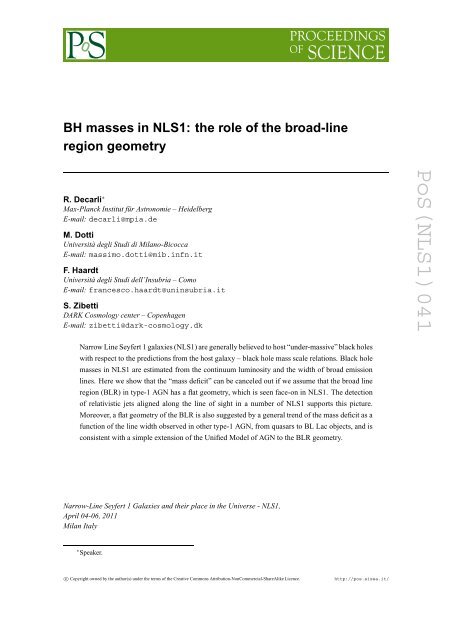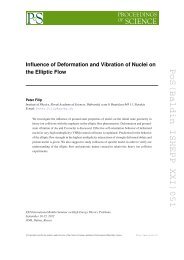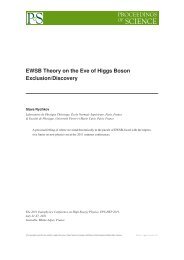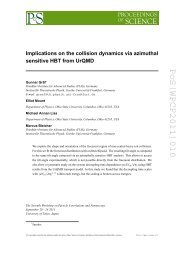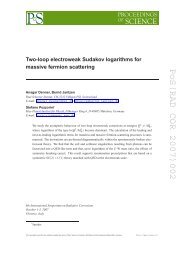BH masses in NLS1 - Proceedings of Science
BH masses in NLS1 - Proceedings of Science
BH masses in NLS1 - Proceedings of Science
You also want an ePaper? Increase the reach of your titles
YUMPU automatically turns print PDFs into web optimized ePapers that Google loves.
<strong>BH</strong> <strong>masses</strong> <strong>in</strong> <strong>NLS1</strong>: the role <strong>of</strong> the broad-l<strong>in</strong>e<br />
region geometry<br />
R. Decarli ∗<br />
Max-Planck Institut für Astronomie – Heidelberg<br />
E-mail: decarli@mpia.de<br />
M. Dotti<br />
Università degli Studi di Milano-Bicocca<br />
E-mail: massimo.dotti@mib.<strong>in</strong>fn.it<br />
F. Haardt<br />
Università degli Studi dell’Insubria – Como<br />
E-mail: francesco.haardt@un<strong>in</strong>subria.it<br />
S. Zibetti<br />
DARK Cosmology center – Copenhagen<br />
E-mail: zibetti@dark-cosmology.dk<br />
Narrow L<strong>in</strong>e Seyfert 1 galaxies (<strong>NLS1</strong>) are generally believed to host “under-massive” black holes<br />
with respect to the predictions from the host galaxy – black hole mass scale relations. Black hole<br />
<strong>masses</strong> <strong>in</strong> <strong>NLS1</strong> are estimated from the cont<strong>in</strong>uum lum<strong>in</strong>osity and the width <strong>of</strong> broad emission<br />
l<strong>in</strong>es. Here we show that the “mass deficit” can be canceled out if we assume that the broad l<strong>in</strong>e<br />
region (BLR) <strong>in</strong> type-1 AGN has a flat geometry, which is seen face-on <strong>in</strong> <strong>NLS1</strong>. The detection<br />
<strong>of</strong> relativistic jets aligned along the l<strong>in</strong>e <strong>of</strong> sight <strong>in</strong> a number <strong>of</strong> <strong>NLS1</strong> supports this picture.<br />
Moreover, a flat geometry <strong>of</strong> the BLR is also suggested by a general trend <strong>of</strong> the mass deficit as a<br />
function <strong>of</strong> the l<strong>in</strong>e width observed <strong>in</strong> other type-1 AGN, from quasars to BL Lac objects, and is<br />
consistent with a simple extension <strong>of</strong> the Unified Model <strong>of</strong> AGN to the BLR geometry.<br />
Narrow-L<strong>in</strong>e Seyfert 1 Galaxies and their place <strong>in</strong> the Universe - <strong>NLS1</strong>,<br />
April 04-06, 2011<br />
Milan Italy<br />
∗ Speaker.<br />
c○ Copyright owned by the author(s) under the terms <strong>of</strong> the Creative Commons Attribution-NonCommercial-ShareAlike Licence. http://pos.sissa.it/<br />
PoS(<strong>NLS1</strong>)041
BLR geometry and black hole <strong>masses</strong> <strong>in</strong> <strong>NLS1</strong> R. Decarli<br />
1. Introduction<br />
Narrow-l<strong>in</strong>e Seyfert 1 galaxies (<strong>NLS1</strong>) are a peculiar class <strong>of</strong> type-1 Active Galactic Nuclei<br />
(AGN) characterized by a modest width <strong>of</strong> permitted broad l<strong>in</strong>es (FWHM = 500–2000 km s −1 ),<br />
weak [O III] and strong Fe II emission l<strong>in</strong>es [1, 2], strong variability, and a s<strong>of</strong>t X-ray excess [3,<br />
4]. They represent about 15% <strong>of</strong> the whole population <strong>of</strong> Seyfert 1 galaxies [5], from optical<br />
spectroscopy classification.<br />
In the context <strong>of</strong> the jo<strong>in</strong>t evolution <strong>of</strong> massive black holes (<strong>BH</strong>s) and their host galaxies, the<br />
most important feature <strong>of</strong> <strong>NLS1</strong> is that they have, on average, lower M<strong>BH</strong> than expected from M<strong>BH</strong>–<br />
host galaxy relations [6], while M<strong>BH</strong> <strong>in</strong> normal broad l<strong>in</strong>e Seyfert galaxies (hereafter, BLS1) are<br />
<strong>in</strong> fairly good agreement to the same relation. On the other hand, AGN lum<strong>in</strong>osities <strong>in</strong> <strong>NLS1</strong> are<br />
comparable to those <strong>of</strong> BLS1. Therefore, the “M<strong>BH</strong> deficit” directly yields high Edd<strong>in</strong>gton ratios<br />
L/LEdd <strong>in</strong> <strong>NLS1</strong> [7]. Relatively modest <strong>BH</strong> <strong>masses</strong> are found from variability studies <strong>of</strong> some<br />
<strong>NLS1</strong> [8, 9, 10] and are sometimes associated with peculiar properties <strong>of</strong> the host galaxy, e.g.,<br />
pseudo-bulges [11] or enhanced star formation [12]. In a <strong>BH</strong>–galaxy co-evolution scenario, <strong>NLS1</strong><br />
could be still on their way to reach the M<strong>BH</strong>–σ∗ relation, i.e., their (comparatively) small <strong>BH</strong>s are<br />
highly accret<strong>in</strong>g <strong>in</strong> already formed bulges, thus mov<strong>in</strong>g towards the BLS1 relation.<br />
However, M<strong>BH</strong> <strong>in</strong> type-1 AGN are usually estimated through the so-called virial paradigm,<br />
accord<strong>in</strong>g to which the clouds <strong>in</strong> the broad l<strong>in</strong>e region (BLR) orbit around the s<strong>in</strong>gularity follow<strong>in</strong>g<br />
purely-gravitational dynamics. Under this assumption,<br />
M<strong>BH</strong> = G −1 RBLR v 2 BLR , (1.1)<br />
where G is the gravitational constant, and RBLR, vBLR are the broad l<strong>in</strong>e region characteristic size<br />
and the velocity <strong>of</strong> broad-l<strong>in</strong>e emitt<strong>in</strong>g clouds. RBLR is found by means <strong>of</strong> the reverberation mapp<strong>in</strong>g<br />
technique [16], or through the RBLR–lum<strong>in</strong>osity relations [17, 18, 19]. The width <strong>of</strong> the broad<br />
emission l<strong>in</strong>es, parametrized e.g. by the full width at half maximum (FWHM), is used as a proxy<br />
for vBLR, assum<strong>in</strong>g a deprojection factor f :<br />
vBLR = f · FWHM. (1.2)<br />
The value <strong>of</strong> f is generally unknown and depends on some assumptions about the geometry <strong>of</strong> the<br />
BLR. In the simple, isotropic scenario f = � 3/4 [13]. If the BLR is rotationally supported (see,<br />
e.g., [14, 15]), an orientation dependence is <strong>in</strong>troduced. If ϑ is the angle between the rotation axis<br />
and the l<strong>in</strong>e <strong>of</strong> sight, the value <strong>of</strong> f for a disk would be:<br />
f = 1<br />
2<br />
� �H<br />
R<br />
�2 + s<strong>in</strong> 2 �−1/2 ϑ<br />
where H and R are the vertical and radial scale lengths <strong>of</strong> the disk. For <strong>in</strong>f<strong>in</strong>itely th<strong>in</strong> disk, f ranges<br />
between 0.5 and <strong>in</strong>f<strong>in</strong>ity as ϑ changes from 90 (edge-on) to 0 (pole-on) degrees. Assum<strong>in</strong>g disks<br />
with f<strong>in</strong>ite thickness would set an upper limit to f , fmax = R/(2H).<br />
In order to measure f , two <strong>in</strong>dependent estimates <strong>of</strong> M<strong>BH</strong> are necessary, only one <strong>of</strong> which<br />
is based on equations 1.1–1.3. The most common approach is to assume that the <strong>BH</strong> follows the<br />
M<strong>BH</strong>–host galaxy relations, therefore the host properties (e.g., σ∗ or the bulge lum<strong>in</strong>osity) can be<br />
2<br />
(1.3)<br />
PoS(<strong>NLS1</strong>)041
BLR geometry and black hole <strong>masses</strong> <strong>in</strong> <strong>NLS1</strong> R. Decarli<br />
Figure 1: Left panel: The distribution <strong>of</strong> BLS1 (empty, black circles) and <strong>NLS1</strong> (squares and triangles) <strong>in</strong><br />
the (σ∗,M<strong>BH</strong>) plane. Data are taken from [26]. Red squares refer to the isotropic case, while blue triangles<br />
refer to the disk-like BLR case with H/R = 0.1. After correct<strong>in</strong>g for the BLR geometry, the two AGN<br />
classes populate the same region <strong>of</strong> the plot. Right panel: the cumulative distribution <strong>of</strong> M<strong>BH</strong> (top) and<br />
L/LEdd (bottom) <strong>of</strong> BLS1 (black, solid l<strong>in</strong>es) and <strong>NLS1</strong>. The red, dot-dashed l<strong>in</strong>e is obta<strong>in</strong>ed assum<strong>in</strong>g an<br />
isotropic BLR, with f = � 3/4. The blue, dashed l<strong>in</strong>e and the magenta, dotted l<strong>in</strong>es are obta<strong>in</strong>ed assum<strong>in</strong>g<br />
a disk-like BLR with H/R=0.1 and 0 respectively. The match with the M<strong>BH</strong> and L/LEdd distributions <strong>of</strong><br />
normal BLS1 is remarkable. Th<strong>in</strong> disks with 0 < H/R < 0.1 best fit the distributions. Figure adapted from<br />
[27].<br />
used as a proxy <strong>of</strong> M<strong>BH</strong> [20, 21, 22, 23] (see however the caveats discussed <strong>in</strong> by Mathur [7] and<br />
[24]). All these studies found average values <strong>of</strong> f exceed<strong>in</strong>g unity, <strong>in</strong> constrast with the simple<br />
expectations from the isotropic model. In this picture, the observed small FWHM <strong>of</strong> <strong>NLS1</strong> broad<br />
l<strong>in</strong>es may be ascribed to a small view<strong>in</strong>g angle with respect to the disc axis, hence no evolutionary<br />
difference is required.<br />
Here we <strong>in</strong>vestigate this latter scenario from three different po<strong>in</strong>t <strong>of</strong> views: the demography <strong>of</strong><br />
<strong>NLS1</strong> with respect to BLS1 (section 2); the geometric deprojection factor f as derived <strong>in</strong> objects<br />
with small <strong>in</strong>cl<strong>in</strong>ation angles ϑ (section 3); and the comparison with the general quasar properties<br />
<strong>in</strong> terms <strong>of</strong> virial black hole <strong>masses</strong> versus host galaxy properties (section 4). Conclusions are<br />
drawn <strong>in</strong> section 5.<br />
2. Break<strong>in</strong>g a cosmic conspiracy?<br />
The key po<strong>in</strong>t <strong>of</strong> the orientation scenario is the assumption that the BLR has a flat geometry,<br />
and that the relatively narrow width <strong>of</strong> permitted l<strong>in</strong>es <strong>in</strong> <strong>NLS1</strong> galaxies is due to small <strong>in</strong>cl<strong>in</strong>ation<br />
angles (pole-on views) rather than <strong>in</strong>tr<strong>in</strong>sically narrow l<strong>in</strong>es. This implies an underestimate <strong>of</strong> the<br />
virial M<strong>BH</strong>, and consequently an overestimate <strong>of</strong> L/LEdd. Under this hypothesis, we can estimate<br />
the average value <strong>of</strong> f for <strong>NLS1</strong> and BLS1 simply requir<strong>in</strong>g that the solid angle <strong>of</strong> pole-on systems<br />
3<br />
PoS(<strong>NLS1</strong>)041
BLR geometry and black hole <strong>masses</strong> <strong>in</strong> <strong>NLS1</strong> R. Decarli<br />
and the one <strong>of</strong> non pole-on systems match the relative fractions <strong>of</strong> <strong>NLS1</strong> and BLS1. Accord<strong>in</strong>g<br />
to the Unified Model <strong>of</strong> AGN, type-1 systems have <strong>in</strong>cl<strong>in</strong>ation angles rang<strong>in</strong>g between 0 and ϑmax<br />
= 40–60 degrees [25]. We can def<strong>in</strong>e a ϑcut so that objects with ϑ < ϑcut are labeled as <strong>NLS1</strong>,<br />
while objects with ϑcut < ϑ < ϑmax are considered BLS1. <strong>NLS1</strong> constitute 15 % <strong>of</strong> the BLS1<br />
population, which yields ϑcut ≈ 15 ◦ , the exact value depend<strong>in</strong>g on H/R. The correspond<strong>in</strong>g average<br />
deprojection factors are 〈 f 〉<strong>NLS1</strong> ≈ 3 and 〈 f 〉BLS1 ≈ 1 (see [27] for details).<br />
Given these values, the position <strong>of</strong> BLS1 <strong>in</strong> the (σ∗,M<strong>BH</strong>) plane is practically unchanged with<br />
respect to the isotropic case assumed, e.g., <strong>in</strong> [26]. On the other hand, <strong>BH</strong> <strong>masses</strong> <strong>in</strong> <strong>NLS1</strong> galaxies<br />
are shifted ≈ 1 dex upwards, thus match<strong>in</strong>g the expectations from the M<strong>BH</strong>–σ∗ relation. Similarly,<br />
the Edd<strong>in</strong>gton ratios are lowered by ≈ 1 dex, match<strong>in</strong>g the distribution observed <strong>in</strong> normal BLS1.<br />
It is remarkable that with the only assumption that BLR is flat <strong>in</strong> all type-1 Seyfert galaxies,<br />
and that they all follow the <strong>BH</strong>–host galaxy relations, we can break the “cosmic conspiracy”<br />
yield<strong>in</strong>g relatively low M<strong>BH</strong> and similarly high L/LEdd <strong>in</strong> AGN hav<strong>in</strong>g the same range <strong>of</strong> AGN<br />
lum<strong>in</strong>osity and host galaxy properties (<strong>in</strong> this case, σ∗). Once the orientation effect are taken <strong>in</strong>to<br />
account, the distributions <strong>of</strong> M<strong>BH</strong> and L/LEdd <strong>in</strong> <strong>NLS1</strong> and BLS1 are <strong>in</strong> good agreement as well<br />
(see Figure 1).<br />
3. The realm <strong>of</strong> small <strong>in</strong>cl<strong>in</strong>ation angles<br />
In order to test the orientation scenario, one would ideally have an <strong>in</strong>dependent way to measure<br />
the <strong>in</strong>cl<strong>in</strong>ation. We therefore focus now on a class <strong>of</strong> type-1 AGN <strong>in</strong> which <strong>in</strong>cl<strong>in</strong>ation angles<br />
are known to be small. Blazars, and BL Lac objects among them, are characterized by strong<br />
cont<strong>in</strong>uum lum<strong>in</strong>osity <strong>in</strong> the optical and radio wavelengths, associated to the synchrotron emission<br />
from a relativistic jet almost aligned with the l<strong>in</strong>e <strong>of</strong> sight, i.e., ϑ ∼ < 10 ◦ [28, 25]. Therefore, we<br />
expect BL Lac objects to show substantially higher f values than the typical quasars.<br />
We select a sample <strong>of</strong> quasars and blazars requir<strong>in</strong>g that the host galaxy has been resolved<br />
and it’s elliptical (so that Lbulge ≈ Lhost), and that broad Mg II or Hα l<strong>in</strong>es have been observed <strong>in</strong><br />
their optical spectra. Quasars are taken from [29, 30], while blazars are collected ma<strong>in</strong>ly from<br />
[31, 32, 33]. The full list <strong>of</strong> sources and references for the data is given <strong>in</strong> [34]. The f<strong>in</strong>al sample<br />
consists <strong>of</strong> 18 blazars (<strong>in</strong>clud<strong>in</strong>g 8 BL Lac objects) and 39 quasars.<br />
Virial <strong>BH</strong> <strong>masses</strong> are derived for each object us<strong>in</strong>g the broad l<strong>in</strong>e width (FWHM) and lum<strong>in</strong>osity<br />
(Ll<strong>in</strong>e) used as a proxy <strong>of</strong> the accretion disk cont<strong>in</strong>uum lum<strong>in</strong>osity 1 . The host galaxy stellar<br />
mass (Mhost) is derived from the rest-frame R-band lum<strong>in</strong>osity <strong>of</strong> the host galaxy, after apply<strong>in</strong>g<br />
k-correction and assum<strong>in</strong>g the mass-to-light ratio <strong>of</strong> a s<strong>in</strong>gle stellar population formed at high redshift<br />
and passively evolv<strong>in</strong>g (see [30, 34]). F<strong>in</strong>ally, we adopt the M<strong>BH</strong>/Mhost ratio and its redshift<br />
dependence as found <strong>in</strong> [30] <strong>in</strong> order to compute f .<br />
Blazars, and <strong>in</strong> particular BL Lac objects, show important (up to 2 dex!) deviations with<br />
respect to the local M<strong>BH</strong>/Mhost relation, if the geometrical factor is not taken <strong>in</strong>to account (see<br />
Figure 2, left). Most importantly, the geometrical factor f shows a clear dependence on the l<strong>in</strong>e<br />
width (see Figure 2, right), so that objects with modest l<strong>in</strong>e width have high (> 3) values <strong>of</strong> f .<br />
1 A fraction <strong>of</strong> the photoioniz<strong>in</strong>g radiation illum<strong>in</strong>at<strong>in</strong>g the BLR <strong>in</strong> blazars could <strong>in</strong> pr<strong>in</strong>ciple come from the jet,<br />
rather than from the accretion disk. However, l<strong>in</strong>e lum<strong>in</strong>osities are found to be <strong>in</strong>dependent <strong>of</strong> the jet-associated cont<strong>in</strong>uum<br />
[35].<br />
4<br />
PoS(<strong>NLS1</strong>)041
BLR geometry and black hole <strong>masses</strong> <strong>in</strong> <strong>NLS1</strong> R. Decarli<br />
Figure 2: Left panel: the (Mhost,M<strong>BH</strong>) plane <strong>in</strong> quasars and blazars <strong>in</strong> our sample. Virial M<strong>BH</strong> with f =1<br />
are plotted along the y-axis. Blazars, and especially BL Lac objects (highlighted by the EW
BLR geometry and black hole <strong>masses</strong> <strong>in</strong> <strong>NLS1</strong> R. Decarli<br />
Figure 3: Left panel: stacked “net” images <strong>of</strong> quasars at 0.3 < z < 0.4 <strong>in</strong> various M<strong>BH</strong> b<strong>in</strong>s. The RGB<br />
images are created as a RGC composite <strong>of</strong> the SDSS zir stacks. Net images are obta<strong>in</strong>ed by subtract<strong>in</strong>g from<br />
the quasar image the image <strong>of</strong> a bright field star, scaled to match the cental brightness <strong>of</strong> the target. The<br />
extended emission <strong>of</strong> the host galaxies is clearly detected after the stack<strong>in</strong>g analysis. Right panel: the (Ll<strong>in</strong>e,<br />
FWHM) plane for SDSS quasars at 0.3 < z < 0.4 (grey crosses). Data are taken from [37]. We reb<strong>in</strong>ned the<br />
sample <strong>in</strong> blocks <strong>of</strong> comparable FWHM and Ll<strong>in</strong>e (thick black l<strong>in</strong>es), and computed the average M<strong>BH</strong> <strong>in</strong> each<br />
b<strong>in</strong> (values <strong>in</strong> red). As expected, M<strong>BH</strong> <strong>in</strong>creases towards to top-right corner <strong>of</strong> the plot. We then performed<br />
our stack<strong>in</strong>g analysis on each b<strong>in</strong>. The result<strong>in</strong>g host galaxy lum<strong>in</strong>osity is shown <strong>in</strong> blue. While the FWHM<br />
<strong>in</strong>creases by a factor ∼ 5 from bottom to top (M<strong>BH</strong> <strong>in</strong>creases by a factor ∼ 20), only a small <strong>in</strong>crease <strong>in</strong><br />
terms <strong>of</strong> Lhost is reported (a factor ∼ 2), suggest<strong>in</strong>g that the l<strong>in</strong>e width, taken without any correction for the<br />
f –FWHM dependence, is not a good tracer <strong>of</strong> M<strong>BH</strong>.<br />
ies are rarely resolved <strong>in</strong> typical SDSS data, <strong>in</strong>dividual net images are noise-dom<strong>in</strong>ated. However,<br />
once we stack few hundred <strong>of</strong> sources, the extended light from the host galaxy is apparent.<br />
We performed our stack<strong>in</strong>g analysis on SDSS quasars rang<strong>in</strong>g between z = 0.3 and z = 1.3<br />
(<strong>in</strong> order to have significant host galaxy emission <strong>in</strong> the SDSS filters), and b<strong>in</strong>n<strong>in</strong>g as a function <strong>of</strong><br />
spectral properties <strong>of</strong> the quasars, e.g., M<strong>BH</strong>, FWHM or lum<strong>in</strong>osity <strong>of</strong> some broad l<strong>in</strong>e, etc. Then<br />
we modeled the stacked image <strong>of</strong> the quasars us<strong>in</strong>g a Sersic pr<strong>of</strong>ile for the host galaxy and the PSF<br />
model derived from the stacked image <strong>of</strong> field stars. The result<strong>in</strong>g magnitudes <strong>in</strong> 4 bands (SDSS<br />
griz) are then compared to get color <strong>in</strong>formation and to give constra<strong>in</strong>ts on the stellar population<br />
<strong>of</strong> the host galaxies. This allows us to probe the dependence <strong>of</strong> the average Lhost and Mhost <strong>in</strong> each<br />
b<strong>in</strong> as a function <strong>of</strong> the quasar properties and the redshift. Details will be presented <strong>in</strong> [36].<br />
In Figure 3, right we plot the 0.3 < z < 0.4 quasars from [37] <strong>in</strong> the (Ll<strong>in</strong>e, FWHM) plane. We<br />
b<strong>in</strong>ned the plane <strong>in</strong> terms <strong>of</strong> l<strong>in</strong>e width and lum<strong>in</strong>osity, and computed the average virial M<strong>BH</strong> <strong>in</strong> each<br />
b<strong>in</strong>. Then, we perfomed our stack<strong>in</strong>g analysis, and evaluated the average host galaxy lum<strong>in</strong>osity.<br />
Surpris<strong>in</strong>gly, while the FWHM <strong>in</strong>creases by a factor ∼ 5 from the bottom to the top <strong>of</strong> the plot, and<br />
the average M<strong>BH</strong> <strong>in</strong>creases by a factor ∼ 20, the host galaxy lum<strong>in</strong>osity changes only by a factor<br />
∼ 2 from the bottom to the top <strong>of</strong> the diagram. This result is <strong>in</strong> disagreement with the observed<br />
6<br />
PoS(<strong>NLS1</strong>)041
BLR geometry and black hole <strong>masses</strong> <strong>in</strong> <strong>NLS1</strong> R. Decarli<br />
M<strong>BH</strong>–Mhost relation. If, as shown before, the geometrical factor shows a dependence on the FWHM,<br />
then the FWHM could have only a limited power <strong>in</strong> predict<strong>in</strong>g the actual vBLR. This could expla<strong>in</strong><br />
the lack <strong>of</strong> correlation between M<strong>BH</strong> and host lum<strong>in</strong>osities from the stack<strong>in</strong>g analysis, as b<strong>in</strong>s are<br />
def<strong>in</strong>ed on virial M<strong>BH</strong> estimates.<br />
5. Conclusions<br />
We showed that the relatively small M<strong>BH</strong> and high L/LEdd values observed <strong>in</strong> <strong>NLS1</strong> may be<br />
fully attributed the orientation <strong>of</strong> the BLR with respect to the l<strong>in</strong>e <strong>of</strong> sight, once a flat BLR geometry<br />
is assumed. This argument can simultaneously break the “cosmic conspiracy” <strong>in</strong> <strong>NLS1</strong>, expla<strong>in</strong><br />
the mismatch between virial M<strong>BH</strong> and M<strong>BH</strong> obta<strong>in</strong>ed from the host galaxy properties <strong>in</strong> blazars, and<br />
accounts for the lack <strong>of</strong> any significant correlation between virial M<strong>BH</strong> and host galaxy lum<strong>in</strong>osities<br />
<strong>in</strong> quasars.<br />
References<br />
[1] Osterbrock D.E., Pogge R.W., 1985, ApJ, 297, 166<br />
[2] R. W. Pogge: A quarter century <strong>of</strong> Narrow-L<strong>in</strong>e Sefert 1s. In: Proceed<strong>in</strong>gs <strong>of</strong> the Workshop<br />
Narrow-L<strong>in</strong>e Seyfert 1 Galaxies and Their Place <strong>in</strong> the Universe, eds L. Fosch<strong>in</strong>i, M. Colpi, L. Gallo,<br />
D. Grupe, S. Komossa, K. Leighly, & S. Mathur. Proceed<strong>in</strong>gs <strong>of</strong> <strong>Science</strong> (<strong>NLS1</strong>) 002 (2011).<br />
[3] Boller T., Tanaka Y., Fabian A., Brandt W.N., Gallo L., Anabuki N., Haba Y., Waughan S., 2003,<br />
MNRAS, 343, L89<br />
[4] Grupe D., Beuermann K., Mannheim K. Thomas H.C., 1999, A&A, 350, 805<br />
[5] Williams R.J., Pogge R.W., Mathur S., 2002, AJ, 124, 3042<br />
[6] Mathur S., et al. 2001, New Astronomy, 6, 321<br />
[7] S. Mathur: Host galaxies <strong>of</strong> <strong>NLS1</strong>s. In: Proceed<strong>in</strong>gs <strong>of</strong> the Workshop Narrow-L<strong>in</strong>e Seyfert 1 Galaxies<br />
and Their Place <strong>in</strong> the Universe, eds L. Fosch<strong>in</strong>i, M. Colpi, L. Gallo, D. Grupe, S. Komossa, K.<br />
Leighly, & S. Mathur. Proceed<strong>in</strong>gs <strong>of</strong> <strong>Science</strong> (<strong>NLS1</strong>) 002 (2011).<br />
[8] Green A.R., McHardy I.M., Lehto H.J., 1993, MNRAS, 265, 664<br />
[9] Hayashida K., 2000, NewAR, 44, 419<br />
[10] McHardy I.M., Koerd<strong>in</strong>g E., Knigge C., Uttley P., Fender R.P., 2006, Nature, 444, 730<br />
[11] R. Davies: Cosmic Evolution <strong>of</strong> <strong>NLS1</strong> and the Growth <strong>of</strong> their Black Holes. In: Proceed<strong>in</strong>gs <strong>of</strong> the<br />
Workshop Narrow-L<strong>in</strong>e Seyfert 1 Galaxies and Their Place <strong>in</strong> the Universe, eds L. Fosch<strong>in</strong>i, M. Colpi,<br />
L. Gallo, D. Grupe, S. Komossa, K. Leighly, & S. Mathur. Proceed<strong>in</strong>gs <strong>of</strong> <strong>Science</strong> (<strong>NLS1</strong>) 002 (2011).<br />
[12] E. Sani: Enhanced star formation <strong>in</strong> Narrow-L<strong>in</strong>e Seyfert 1 galaxies. In: Proceed<strong>in</strong>gs <strong>of</strong> the Workshop<br />
Narrow-L<strong>in</strong>e Seyfert 1 Galaxies and Their Place <strong>in</strong> the Universe, eds L. Fosch<strong>in</strong>i, M. Colpi, L. Gallo,<br />
D. Grupe, S. Komossa, K. Leighly, & S. Mathur. Proceed<strong>in</strong>gs <strong>of</strong> <strong>Science</strong> (<strong>NLS1</strong>) 002 (2011).<br />
[13] H. Netzer, 1990, <strong>in</strong> Blandford R.D., Netzer H., Woltjer L., eds, Active Galactic Nuclei, Spr<strong>in</strong>ger,<br />
Berl<strong>in</strong> , p. 137<br />
[14] Wills B.J., Browne I.W.A., 1986, ApJ, 302, 56<br />
[15] Bian W. & Zhao Y., 2004, MNRAS, 352, 823<br />
7<br />
PoS(<strong>NLS1</strong>)041
BLR geometry and black hole <strong>masses</strong> <strong>in</strong> <strong>NLS1</strong> R. Decarli<br />
[16] Blandford R.D., McKee C.F., 1982, ApJ, 255, 419<br />
[17] Kaspi S., Smith P.S., Netzer H., Maoz D., Jannuzi B.T., Giveon U., 2000, ApJ, 533, 631<br />
[18] Kaspi S., Maoz D., Netzer H., Peterson B.M., Vestergaard M., Jannuzi B.T., 2005, ApJ, 629, 61<br />
[19] Kaspi S., Brandt W.N., Maoz D., Netzer H., Schneider D.P., Shemmer O., 2007, ApJ, 659, 997<br />
[20] Onken C.A., Ferrarese L., Merritt D., Peterson B.M., Pogge R.W., Vestergaard M., Wandel A., 2004,<br />
ApJ, 615, 645<br />
[21] Labita M., Treves A., Falomo R., Uslenghi M., 2006, MNRAS, 373, 551<br />
[22] Decarli R., Labita M., Treves A., Falomo R., 2008a, MNRAS, 387, 1237<br />
[23] Graham A.W., Onken C.A., Athanassoula E., Combes F., 2011, MNRAS, 412, 2211<br />
[24] Batcheldor D., 2010, ApJ, 711L, 108<br />
[25] Urry C.M., Padovani P., 1995, PASP, 107, 803<br />
[26] Grupe D., Mathur S., 2004, ApJ, 606L, 41<br />
[27] Decarli R., Dotti M., Fontana M., Haardt F., 2008b, MNRAS Letters, 386, 15<br />
[28] Ghisell<strong>in</strong>i G., Padovani P., Celotti A., Maraschi L., 1993, ApJ, 407, 65<br />
[29] Decarli R., Falomo R., Treves A., Kotila<strong>in</strong>en J.K., Labita M., Scarpa R., 2010a, MNRAS, 402, 2441<br />
[30] Decarli R., Falomo R., Treves A., Labita M., Kotila<strong>in</strong>en J.K., Scarpa R., 2010b, MNRAS, 402, 2453<br />
[31] Scarpa R., et al., 2000, ApJ, 532, 740<br />
[32] Kotila<strong>in</strong>en J.K., Falomo R., & Scarpa R., 1998, A&A, 332, 503<br />
[33] Nilsson K., Pursimo T., Heidt J., Takalo L.O., SillanpäÄ., Br<strong>in</strong>kmann W., 2003, A&A, 400, 95<br />
[34] Decarli R., Dotti M., Treves A., 2011, MNRAS, 413, 39<br />
[35] Corbett E.A., Rob<strong>in</strong>son A., Axon D.J., Hough J.H., 2000, MNRAS, 311, 485<br />
[36] Decarli R., Zibetti S., 2011, <strong>in</strong> preparation<br />
[37] Shen Y., Richards G.T., Strauss M.A., Hall P.B., Schneider D.P., Snedden S., Bizyaev D., Brew<strong>in</strong>gton<br />
H., et al., 2010, arXiv:1006.5178<br />
8<br />
PoS(<strong>NLS1</strong>)041


